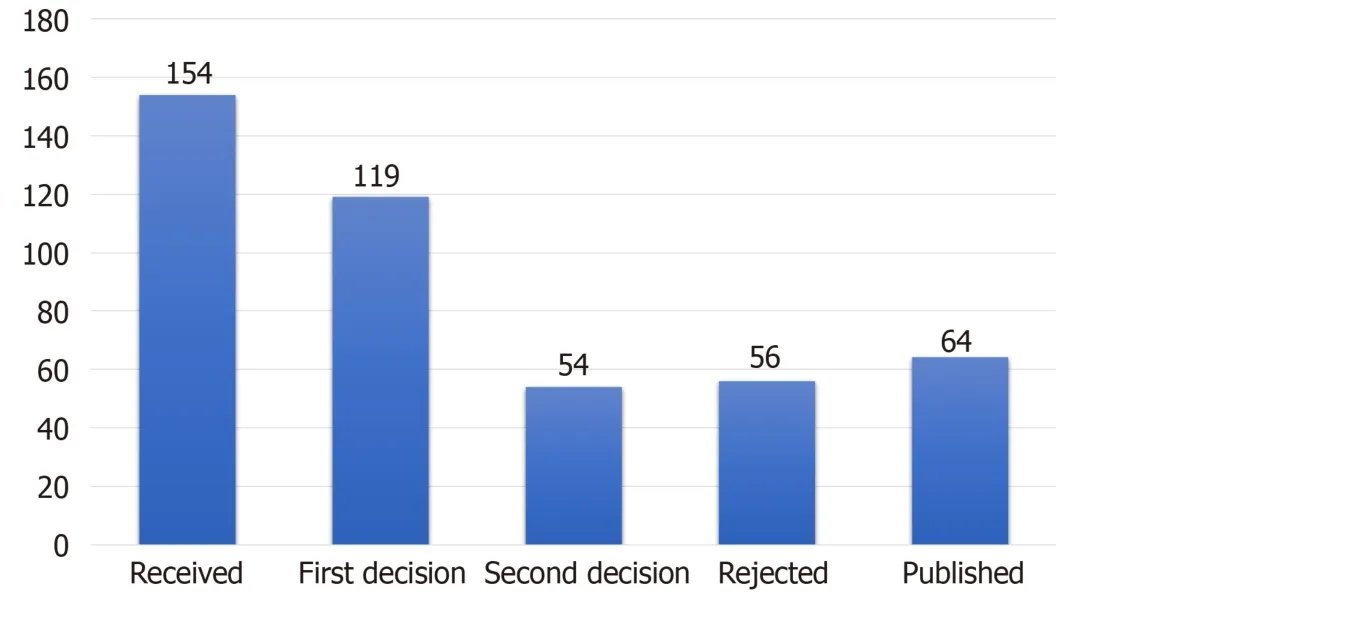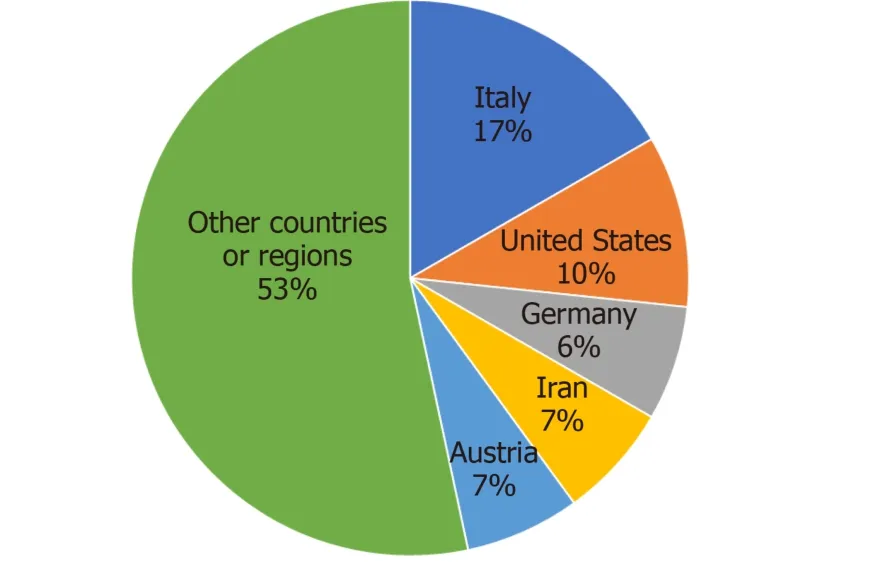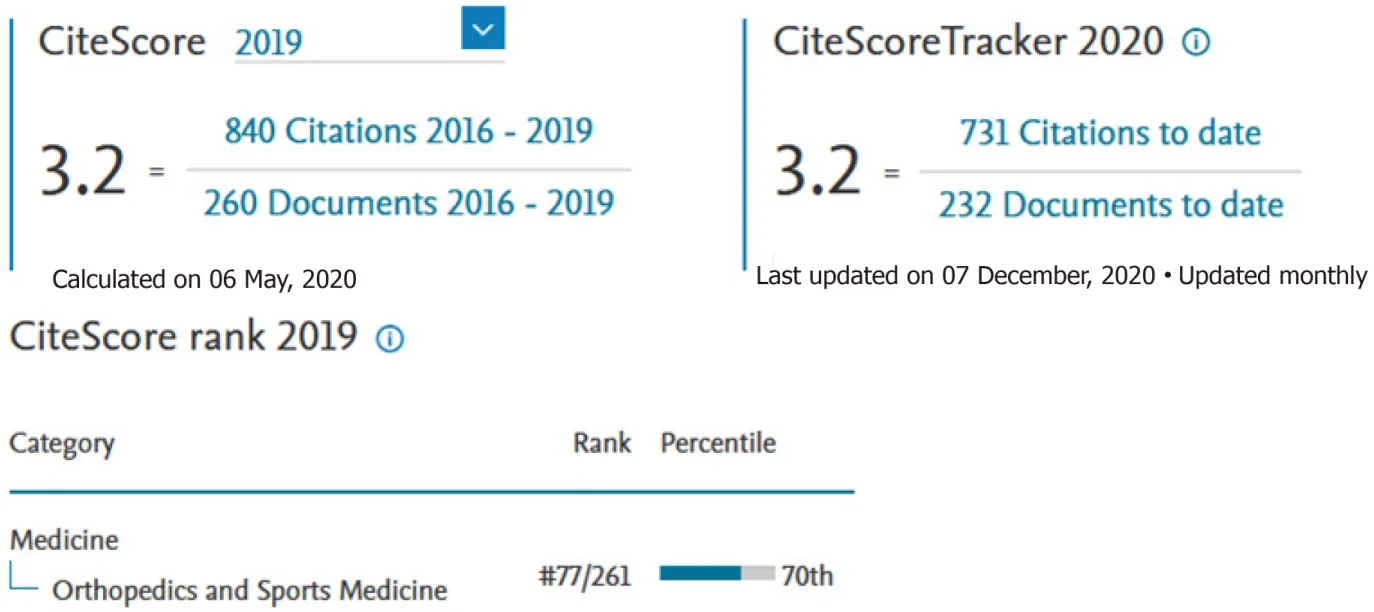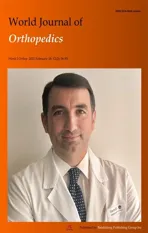New Year's greeting and overview of World Journal of Orthopedics in 2021
2021-03-11JinLeiWangMassimilianoLeigheb
Jin-Lei Wang, Massimiliano Leigheb
Jin-Lei Wang, Editorial Office, Baishideng Publishing Group Inc, Pleasanton, CA 94566, United States
Massimiliano Leigheb, Orthopaedics and Traumatology Unit, “Maggiore della Carità” Hospital, Department of Health Sciences, University of Piemonte Orientale, Novara 28100, Italy
Abstract On behalf of the Editorial Office of World Journal of Orthopedics (WJO), we extend our sincere gratitude to our authors, subscribers, readers, Editorial Board members, and peer reviewers, thanking each and every one for their contributions to WJO in 2020 and with wishes for a Happy New Year. It was the support of all our Editorial Board members and peer reviewers that allowed the Baishideng Publishing Group Inc to successfully carry out the complete peer review, editing and publishing processes for WJO in 2020. We have analyzed the data of WJO's manuscript submissions and article publications in 2020, the invited manuscripts for 2021, manuscript peer review, composition of Editorial Board, and citation of WJO's articles, and present the findings here. We expect to be even more productive and to further raise the academic rank of WJO in 2021.
Key Words: World Journal of Orthopedics; Acknowledgments; New Year's message; Editorial Board; Journal development
INTRODUCTION
As editors ofWorld Journal of Orthopedics(WJO), we extend our sincere gratitude to our authors, subscribers, readers, Editorial Board members, and peer reviewers, thanking them for their contributions to theWJOin 2020 and wishing them a Happy New Year. We also give thanks for the support of all Editorial Board members and peer reviewers, whose efforts allowed for the Baishideng Publishing Group Inc (BPG) to successfully carry out the complete peer review, editing and publishing processes forWJOin 2020.
ACADEMIC INFLUENCE OF WJO
TheWJOwas launched by the BPG on November 18, 2010, and since then has grown into a high-quality, online, open-access, peer-reviewed journal. While we are celebratingWJO’s 11-year anniversary, we are very proud to share with you that since its first publication,WJOhas published 698 articles that have been cited 8676 times.
In 2020,WJOreceived a total of 154 manuscripts for consideration of publication. Among the 119 which received a first decision by the Science Editor Development Department, 54 were edited and processed and advanced to the second decision, 56 (36.4%, 56/154) were rejected, and 64 (41.6%, 64/154) were published online by the Production Department (Figure 1)[1]. Among the 64 published articles, 18 (28.1%, 18/64) were invited manuscripts and 46 (71.9%, 46/64) were unsolicited manuscripts; in addition, 28 (43.8%, 28/64) were original articles, 19 (29.7%, 19/64) were review articles, 15 (23.4%, 15/64) were case reports, 1 (1.6%, 1/64) was an editorial and 1 (1.6%, 1/64) was ‘other’ (Figure 2A). The authors of those articles hail from 24 countries or regions. Among them, 14 (21.9%, 14/64) were authored by researchers from the United States, 5 (7.8%, 5/64) from the United Kingdom, 5 (7.8%, 5/64) from the Netherlands, 4 (6.3%, 4/64) from Italy, and 36 (56.3%, 36/64) from other countries or regions (Figure 2B).
As of December 31, 2020,WJOhas received a total of 204 titles submitted for invited manuscripts for consideration of publication in 2021, including 116 (56.9%) review articles, 80 (39.2%) original articles, and 8 (3.9%) editorials. Among them, 28 (13.7%) had been submitted online and 176 (86.3%) have not been submitted yet (Figure 3).
In 2020, 5609 invitations were sent out to peer reviewers and Editorial Board members to conduct peer review ofWJOmanuscripts, yielding 660 acceptances (11.7%, 660/5609), 603 declines (10.8%, 603/5609), and 4346 non-responses (77.5%, 4346/5609) (Figure 4). Among the peer reviewers and editorial board members who accepted invitations, 224 (33.9%, 224/660) submitted the peer review report on time, 425 (64.4%, 425/660) failed to submit the peer review report on time, and 11 have not submitted the peer review report yet.
TheWJOEditorial Board is composed of 60 members[2], and the Editorial Office has received 32 new applications to evaluate for inclusion on the member list. The 60 Editorial Board members came from 27 countries or regions. Among them, 10 (16.7%) are from Italy, 6 (10%) from the United States, 4 (6.7%) from Germany, 4 (6.7%) from Iran, 4 (6.7%) from Austria, and 32 (53.3%) from other countries or regions (Figure 5), among which 40 (66.7%) have conducted peer review and 20 (33.3%) have yet to conduct their first peer review.
In 2020, the number of total visits to theWJOhomepage was about 254463, of which 26.7% of those visits were from the United States, 10.8% from the United Kingdom, and 8.2% from China[3]. The number of total downloads to theWJOarticles is about 176327, of which 47.9% of those visits have been from the United States, 11.2% from China, and 8.4% from Germany[4](Figure 6).
As of January 4, 2021, according to data from the Web of Science, theWJOpublished 88 articles in 2018-2019 from authors in 27 countries or regions. Among them, 33 authors (37.5%, 33/88) came from the United States, 12 (13.6%, 13/88) from the United Kingdom, and 7 (8.0%, 7/88) from Italy. These 88 published articles included 83 classified as “article” or “review” and yielded total cites of 190 times in 2020.

Figure 1 World Journal of Orthopedics 2020 manuscript processing.

Figure 2 Bibliographic data for articles published by the World Journal of Orthopedics in 2020.
According to data from Scopus, theWJO’s CiteScore for 2019 is 3.2 and Scopus CiteScore rank 2019: Orthopedics and sports medicine is 77/261 (Figure 7).
CONCLUSION
At present,WJOstill has some problems to be solved, including: (1) A lower than desired number of manuscript submissions, especially of high-quality original and review manuscripts; (2) A lower than desired number of peer review reports received for each manuscript; (3) The academic quality of published articles should be further improved; (4) A lower than desired number of submissions of invited manuscripts from Editorial Board members; and (5) An insufficient number of Editorial Board members, which presents a challenge to the peer review process for some manuscripts.
With continued dedicated support from all our authors, reviewers, Editorial Board members and readers, we expect to be more productive in this new year. For our part, we commit to working with you all to raise the academic rank ofWJOin 2021. In order to achieve these goals, we will invite more scientists in the field of orthopedics to join theWJOEditorial Board, more active scientists to conduct peer review forWJOmanuscripts, and more scientists to contribute high-quality original and review manuscripts toWJO. By publishing more high-quality articles, theWJOwill be able to make more substantive contributions to the development of basic medical and clinical research in the field of orthopedics.
We remain open to any suggestions that could improveWJO’s operation and publication. Please feel free to contact us at j.l.wang@wjgnet.com, if you have any questions or suggestions onWJO.
Once again, on behalf of the Editorial Office ofWJO, we wish you and your families the best for the New Year.

Figure 3 Titles of invited manuscripts submitted for the various types of articles for consideration of publication in 2021 by the World Journal of Orthopedics.

Figure 4 In 2020, 5609 invitations were sent out to peer reviewers and Editorial Board members to conduct peer review of World Journal of Orthopedics manuscripts.

Figure 5 World Journal of Orthopedics Editorial Board members are from 27 countries or regions.

Figure 6 Number of total visits to the World Journal of Orthopedics homepage and number of total downloads of World Journal of Orthopedics articles in 2020.

Figure 7 Formula for the anticipated 2019 CiteScore for the World Journal of Orthopedics.
杂志排行
World Journal of Orthopedics的其它文章
- Diabetic foot: Which one comes first, the ulcer or the contracture?
- Evaluation of joint awareness after acetabular fracture: Validation of the Forgotten Joint Score according to the COSMIN checklist protocol
- Interobserver and intraobserver agreement for Letournel acetabular fracture classification system using 3-dimensional printed solid models
